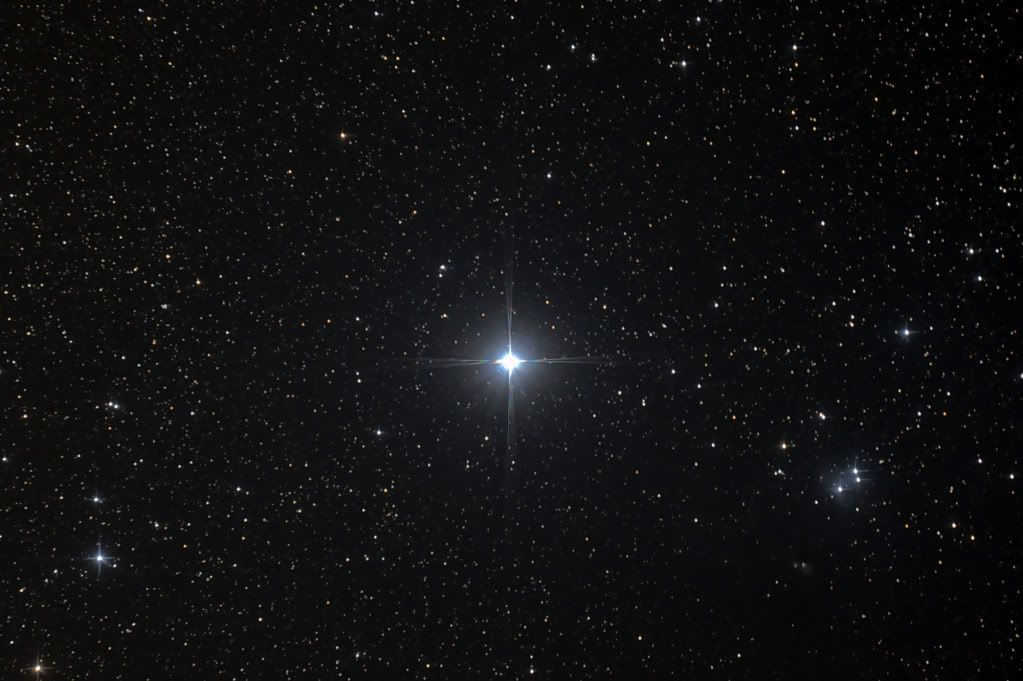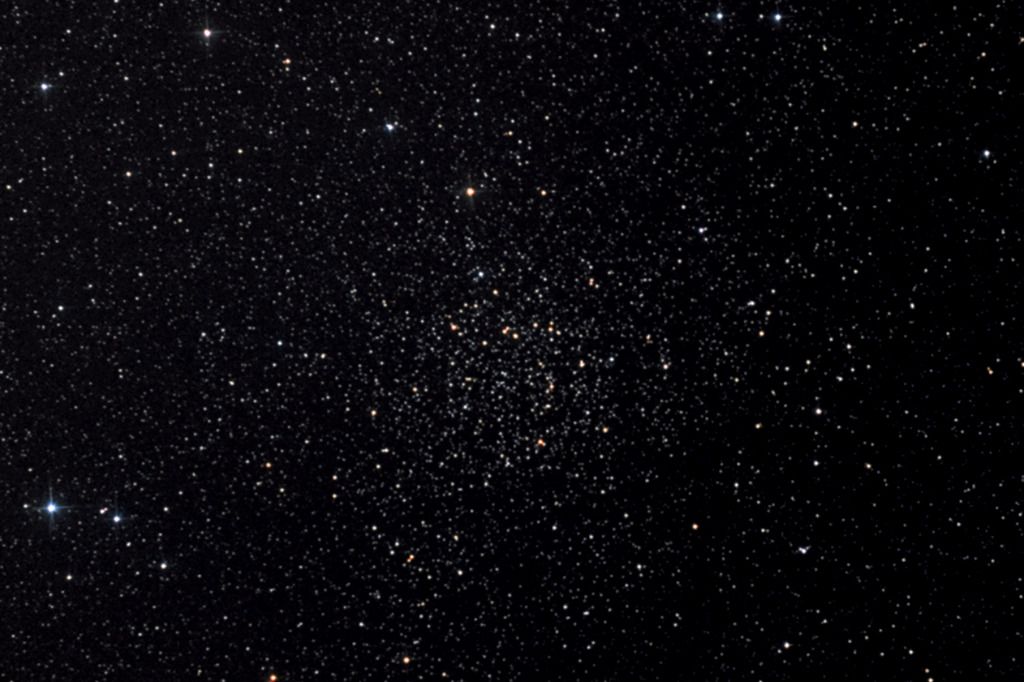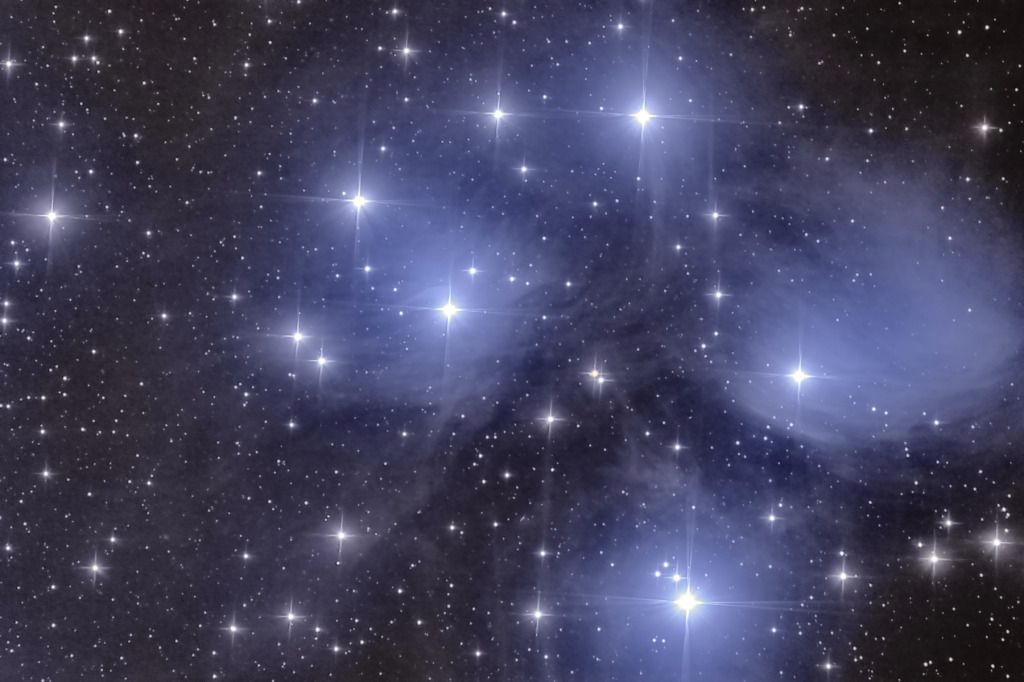Posts: 1571
Threads: 179
Joined: October 14, 2010
Reputation:
35
Sometimes its nice to just look at stars, lots of them.
December 11, 2012 at 9:20 am
(This post was last modified: December 11, 2012 at 10:22 am by Tiberius.)
But one in particular in this image is interesting.
Caph (Beta Cassiopeiae), in Cassiopeia.
From Wikepedia:
http://en.wikipedia.org/wiki/Beta_Cassiopeiae
Beta Cassiopeiae (β Cas, β Cassiopeiae) is a Delta Scuti variable star in the constellation Cassiopeia. It is a subgiant or giant star belonging to the spectral class F2, with a mean apparent magnitude of +2.27 and absolute magnitude of +1.16. It has the traditional name Caph, from the Arabic word كف kaf, "palm" (i.e. reaching from the Pleiades), also known as Al Sanām al Nākah.[9] Another Arabic name is al-Kaff al-Khadib.[11
β Cassiopeiae is a yellow-white hued subgiant or giant of stellar class F2III-IV, with a surface temperature of 6,700 Kelvin.[12] More than three times the size of and 28 times brighter than the sun, Caph has an absolute magnitude of +1.16. It was once an A-type star with about double the sun's mass.[7] It is now in the process of cooling and expanding to become a red giant. Its core is likely to have used up its hydrogen and is shrinking and heating, while its outer envelope of hydrogen is expanding and cooling. Stars do not spend much time in this state and are relatively uncommon. Caph's corona is unusually weak.[12]
β Cassiopeiae is a variable star of the Delta Scuti type, in fact the second brightest of such stars in the sky after Altair.[14] It is a monoperiodic pulsator,[15] with a brightness that ranges from magnitude +2.25 to +2.31 with a period of 2.5 hours.[12] This type of variables includes subgiant or main sequence stars of spectral classes F5–A0, having masses between 1.5–2.5 solar masses and nearing the end of their core hydrogen fusion lifetime.[15] Their pulsations are related to the same helium instability strip on the Hertzsprung–Russell diagram as that of classical Cepheids. Delta Scuti stars are located at the intersection of the strip with the main sequence.[16]
This star is rotating at about 92% of its critical speed, completing a full rotation every 1.12–1.16 days. This is giving the star an oblate spheroid shape with an equatorial bulge that is 24% larger than the polar radius. This shape is causing the polar region to have a higher temperature than the equator: the temperature difference is about 1,000 K. The axis of rotation is inclined about 20° to the line of sight from the Earth.[7]
β Cassiopeiae is a binary star, with a faint companion, which orbits it every 27 days. Little else is known about this companion.[17]
β Cassiopeiae is approximately 54.7 ± 0.3 ly from our solar system.
Image was taken on 11/12/2012 at the LAS James Baker Observatory, in Curby, Indiana.
'The difference between a Miracle and a Fact is exactly the difference between a mermaid and seal. It could not be expressed better.'
-- Samuel "Mark Twain" Clemens
"I think that in the discussion of natural problems we ought to begin not with the scriptures, but with experiments, demonstrations, and observations".
- Galileo Galilei (1564-1642)
"In short, Meyer has shown that his first disastrous book was not a fluke: he is capable of going into any field in which he has no training or research experience and botching it just as badly as he did molecular biology. As I've written before, if you are a complete amateur and don't understand a subject, don't demonstrate the Dunning-Kruger effect by writing a book about it and proving your ignorance to everyone else! "
- Dr. Donald Prothero
Posts: 25314
Threads: 239
Joined: August 26, 2010
Reputation:
155
RE: Sometimes its nice to just look at stars, lots of them.
December 11, 2012 at 9:27 am
Beautiful. Simply beautiful.
At the age of five, Skagra decided emphatically that God did not exist. This revelation tends to make most people in the universe who have it react in one of two ways - with relief or with despair. Only Skagra responded to it by thinking, 'Wait a second. That means there's a situation vacant.'
Posts: 1571
Threads: 179
Joined: October 14, 2010
Reputation:
35
NGC 7789, Open Cluster In Cassiopeia
December 11, 2012 at 9:28 am
(This post was last modified: December 11, 2012 at 10:23 am by Tiberius.)
NGC 7789 is an open cluster[1] in Cassiopeia that was discovered by Caroline Herschel in 1783. Her brother William Herschel included it in his catalog as H VI.30. This cluster is also known as "The White Rose" Cluster or "Caroline's Rose" Cluster because when seen visually, the loops of stars and dark lanes look like the swirling pattern of rose petals as seen from above.
NGC 7789 is about 7,600 ly from our solar system.
This image was taken on 08/15/2012 at the LAS James Baker Observatory, in Curby, Indiana
Messier 45, in Taurus
This was typically a very tough egg to crack. I had unknowingly bumped the white balance button on my camera right before I took the frames for this image, with the result that my color data was unrecoverable. The color in this image was generated by creating synthetic color channels. It isn't pefect, but it is close. Still, this is the best image of this cluster I've managed to date.
One of the most interesting things about this cluster is that it is far older than the dust around it would suggest. For a long time, astronomers thought that the cluster was formed within the dust cloud in which it is embedded. That is, until someone far smarter than I am decided to measure the speed and direction of movement of these stars. They discovered that the cluster is moving as one at the same velocity and from the same direction, both of which are different from the velocity and direction the dust is moving. Yep, that means that the cluster just happened on the dust cloud, which apparently was just in its way. The Pleiades are 100 million years old, and are only about 400 light years from us, making them the closest, and largest star cluster near our solar system.
Image:
8x5 min: 40 min total at ISO 800
11 darks, 42 flats, 32 bias frames
Processed with deepSky Stacker and Adobe Photoshop CS3 using the methods of Scott Rosen
Equipment:
Camera: Hutech Modified Canon T1i
Scope: Modified 200m f5 Konus Newtonian with Baader MPCC coma corrector and Baader UV/IR cut filter
Mount: Losmandy G-11 Gemini V.1.04
Tripod: Losmandy Heavy Duty
Autoguide Scope: 80mm f5 Orion Shorty
Autoguide Camera: Orion Starshooter using PhD Guiding
Image acquired on 10/10/2012 at the LAS James Baker Observatory, Curby, Indiana.
'The difference between a Miracle and a Fact is exactly the difference between a mermaid and seal. It could not be expressed better.'
-- Samuel "Mark Twain" Clemens
"I think that in the discussion of natural problems we ought to begin not with the scriptures, but with experiments, demonstrations, and observations".
- Galileo Galilei (1564-1642)
"In short, Meyer has shown that his first disastrous book was not a fluke: he is capable of going into any field in which he has no training or research experience and botching it just as badly as he did molecular biology. As I've written before, if you are a complete amateur and don't understand a subject, don't demonstrate the Dunning-Kruger effect by writing a book about it and proving your ignorance to everyone else! "
- Dr. Donald Prothero
Posts: 6300
Threads: 78
Joined: May 14, 2011
Reputation:
82
RE: Sometimes its nice to just look at stars, lots of them.
December 11, 2012 at 9:59 am
Twinkle, twinkle little star.. 
When I was young, there was a god with infinite power protecting me. Is there anyone else who felt that way? And was sure about it? but the first time I fell in love, I was thrown down - or maybe I broke free - and I bade farewell to God and became human. Now I don't have God's protection, and I walk on the ground without wings, but I don't regret this hardship. I want to live as a person. -Arina Tanemura
Posts: 5170
Threads: 364
Joined: September 25, 2012
Reputation:
61
RE: Sometimes its nice to just look at stars, lots of them.
December 11, 2012 at 10:05 am
Lived in Hamburg for some time.
No stars.
Only one big, disgusting, ugly, thik, grey coat of smog..................... illuminated by the cities lights to have the color of a horrible hangover piss.
One underestimates how depressing that can be.
Posts: 25314
Threads: 239
Joined: August 26, 2010
Reputation:
155
RE: Sometimes its nice to just look at stars, lots of them.
December 11, 2012 at 10:20 am
It's a bit like that here in Walsall, seeing as I'm a stone's throw from the town centre... all that street lighting and the lights of local businesses (not to mention one of our nightclubs with a great big fuck-off searchlight on the roof - who are they trying to attract, sodding Batman or something?) So we don't tend to see many stars, only the brightest ones and the major planets. In fact, I only saw the Milky Way for the first time in my life on a family holiday to a remote spot in the Highlands a few years ago.
I once read of an incident that supposedly happened in New York, I think, during WWII. It may or may not be true, like most of these things, but apparently there was a massive city-wide power cut and a resulting blackout. Before long, the police became deluged by panicked citizens calling to report scary-looking lights in the sky; of course, they turned out to be the stars, which most people had presumably never seen due to all the lighting at night.
At the age of five, Skagra decided emphatically that God did not exist. This revelation tends to make most people in the universe who have it react in one of two ways - with relief or with despair. Only Skagra responded to it by thinking, 'Wait a second. That means there's a situation vacant.'
Posts: 69247
Threads: 3759
Joined: August 2, 2009
Reputation:
258
RE: Sometimes its nice to just look at stars, lots of them.
December 11, 2012 at 11:35 am
(December 11, 2012 at 9:59 am)Kayenneh Wrote: Twinkle, twinkle little star.. 
Or, as otherwise known
Mozart: Variations for Piano on "Ah, vous dirai-je maman," K. 265
Posts: 25314
Threads: 239
Joined: August 26, 2010
Reputation:
155
RE: Sometimes its nice to just look at stars, lots of them.
December 11, 2012 at 11:40 am
Scintillate, scintillate, globule vivific,
Fain would I fathom thy nature specific,
Loftily poised in the ether capacious,
Strongly resembling a gem carbonaceous!
When torrid Phoebus removeth his presence,
Ceasing to lamp us with fierce incandescense,
Then you illumine the regions supernal,
Scintillate, scintillate semper nocturnal.
The traveller on lustreless perigrination,
Gratefully hails your minute coruscation,
He could not determine his journey’s direction,
But for your bright scintillitating protection.
At the age of five, Skagra decided emphatically that God did not exist. This revelation tends to make most people in the universe who have it react in one of two ways - with relief or with despair. Only Skagra responded to it by thinking, 'Wait a second. That means there's a situation vacant.'
Posts: 1127
Threads: 20
Joined: May 11, 2011
Reputation:
14
RE: Sometimes its nice to just look at stars, lots of them.
December 11, 2012 at 12:18 pm
(This post was last modified: December 11, 2012 at 12:26 pm by Darth.)
Hey, arent we getting a really good meteor shower in 2 days time? The Gemenid meteor shower? I'd almost forgotten! I shall have to set my alarm and such, after finding out when to set it.
Hmm, seems it's tomorrow tonight and it's a new moon, so extra visible meteor shower 
Nemo me impune lacessit.
Posts: 2281
Threads: 16
Joined: January 17, 2010
Reputation:
69
RE: Sometimes its nice to just look at stars, lots of them.
December 11, 2012 at 12:45 pm
(December 11, 2012 at 11:40 am)Stimbo Wrote: Scintillate, scintillate, globule vivific,
Fain would I fathom thy nature specific,
Loftily poised in the ether capacious,
Strongly resembling a gem carbonaceous!
When torrid Phoebus removeth his presence,
Ceasing to lamp us with fierce incandescense,
Then you illumine the regions supernal,
Scintillate, scintillate semper nocturnal.
The traveller on lustreless perigrination,
Gratefully hails your minute coruscation,
He could not determine his journey’s direction,
But for your bright scintillitating protection. Good work! Deserves another Rating +1.
But I can't.
Sorry.
Sum ergo sum
|















